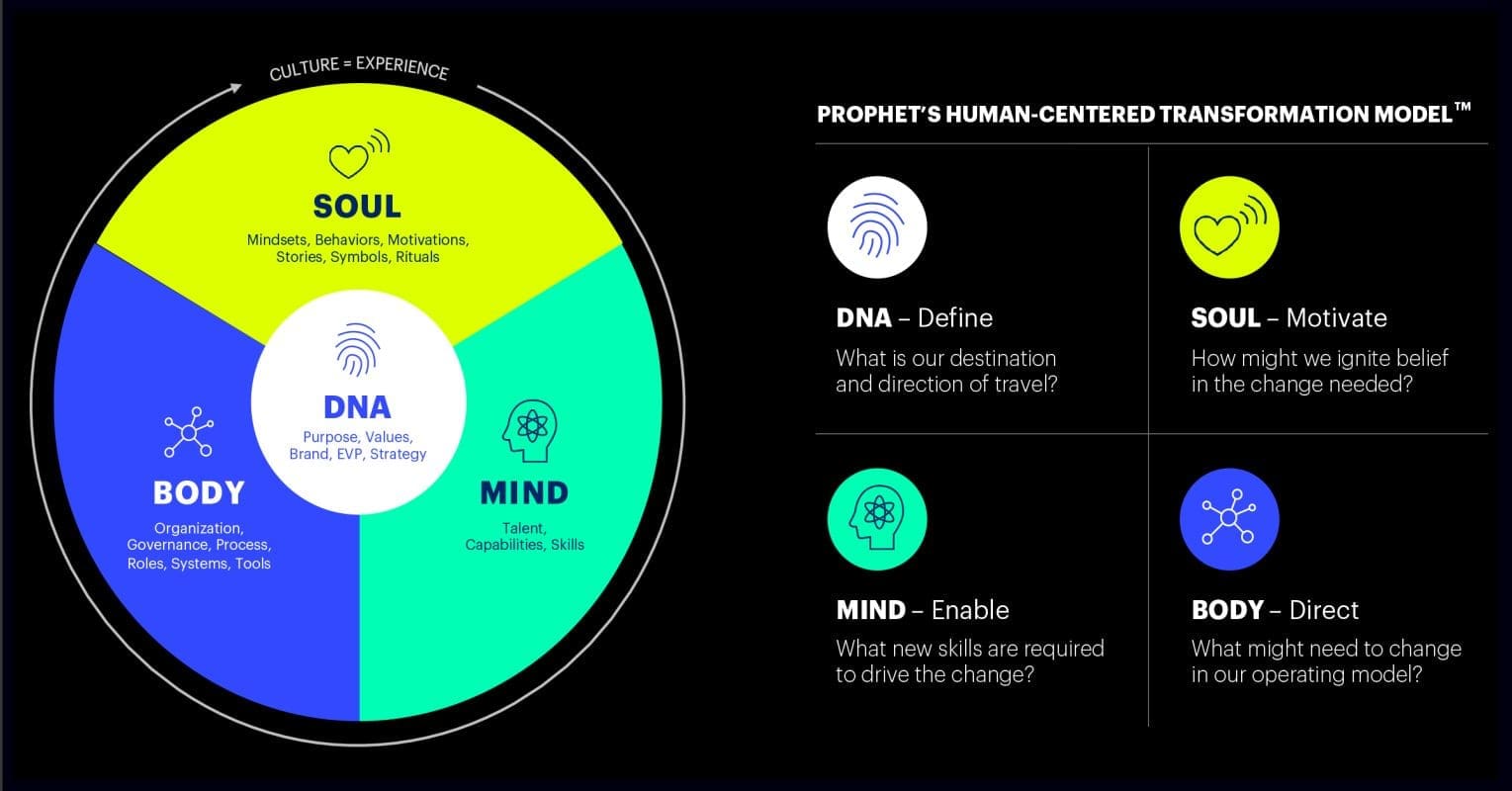BLOG
The Body, Mind and Soul of Digitally Evolved Organizations
Getting employees to believe in transformation efforts requires a bold new way of thinking.
Why Corporate Culture is the Biggest Impediment to Digital Transformation
When it comes to digital transformation, many companies say the hardest part is changing the culture itself. They often do a great job signposting new corporate values, like innovation and agility. They hold town halls and may even pour millions into expensive technology initiatives. At best, they get poor adoption rates. But often the worst happens: Nothing changes.
After a few rounds of announcements, disappointed (and increasingly cynical) employees sit back and wait. Their leaders tell them that things must change, but then offer platitudes about their position as traditional industry leaders. “There will always be a need for pharmaceutical sales reps,” they might say, or “Those start-ups don’t even make money.”
Meanwhile, employees watch, keenly aware of digital natives that threaten to disrupt their own industry. They have few choices: They can leave for fleeter firms, or stay put, watching the clock tick.
Do Your Employees Believe in Your Digital Transformation?
For most older organizations, the digital age presents a very specific challenge: How might we compete when the assumptions about where and how value is created have changed? They know the answers lie in digital, and it’s not as though these born-before-the-Internet companies have been standing still. Most have many digital things–websites, sophisticated email strategies, social media and probably at least one mobile application.
Still, progress is slow. And employees, who spend their outside time experiencing companies like Amazon, Netflix and Spotify, are painfully aware of how behind the curve their own employers are. Convincing them that true digital transformation is even plausible, never mind possible, is difficult. Why should they believe you?
“How might we compete when the assumptions about where and how value is created have changed?”
What makes it worse is that even though employees can see–everyone can see–that the company needs to make radical changes, internal strategy teams focus on gradual tweaks and long-term transformation, to minimize disruption. While employees can see the company needs to travel vast distances to catch up, their employers are only taking baby steps.
Relatively few organizations have truly asked themselves, “What would we look like if we’d been designed in the last 20 years?” and then set a rapid roadmap, three years at the most, for working backward to create those capabilities and the culture to support them.
Challenges of an Incremental Approach to Digital Transformation
And the unrecognized truth is that taking an incremental approach to digital transformation comes at a tremendous cost. The widely reported “retail apocalypse” is an obvious example. Over the last 25 years, nearly all retailers worked hard, but slowly, to launch to e-commerce websites and mobile apps. They tried to balance conflicts between physical and virtual stores, creating expensive loyalty programs that gathered customer data.
But their incremental approach was often too little, too late. In the U.S., for example, grocers didn’t fully anticipate the speed with which Amazon and Walmart would enter their markets with advanced digital capabilities for serving shoppers. Dozens of chains, including Toys R Us and Payless Shoes, were forced into bankruptcy by online competitors. Mainstream and luxury department stores, from JC Penney in the US to Harvey Nichols in the UK, are teetering. Across Europe, high streets have been similarly decimated, with House of Fraser the latest to struggle. And in Asia, online retail continues to sizzle, led by Alibaba’s Taobao and Tmall, as well as JD.com.
That’s just one industry. Look at what Airbnb is doing to hotels and Uber and Lyft to taxi operators, or the way Grab is shaking up food delivery in Asia. These digital companies are succeeding because they know we live in an experience-first world. Customer wants are rapidly evolving, requiring dramatically new levels of organizational flexibility, agility and adaptability.
And that responsiveness is about technology, yes. But it’s very much about humans. Data can tell us what people have done in the past and what they need, but it can’t create new products and services. Digital technology can’t see trends, nor help you decide how to shift a business as markets evolve. It can’t drive culture, those values and beliefs that make people want to come to work for you every day.
Transforming an Organization’s Body, Mind and Soul

At Prophet, we’ve started thinking about digital transformation as rewiring the Body, Mind and Soul of the enterprise.
Body: Reinvent the Operating Model
A company is trained and equipped to achieve its vision if it can do three seemingly simple things:
- Design customer-focused business processes unencumbered by bureaucracy
- Create an organization with the right roles, empowered to make those processes fleet and effective
- Shape a governance structure that makes it supremely easy to do the right things, versus being designed purely to block the wrong things
Modern operating models frequently depart from traditional approaches, organizing communities of practice instead of departments and using multi-disciplinary teams to understand customer needs and design new products, services and experiences.
For instance, a large financial services firm determined that its key strategic goal was to dominate the industry in customer experience and differentiate itself through service. But it was bogged down by business units so siloed that its best customers, those who purchased the broadest range of products, got the worst experience. Working with our team, the leaders agreed on a digital transformation vision. Two years after launching its new operating model, it has moved from being the customer-experience laggard to an industry leader, according to several analysts.
Mind: Energize the Talent
The relentless pace of innovation means that many companies struggle with a mismatch of skills and capabilities. This can even happen to digital companies: We recently worked with a global tech behemoth that couldn’t find a market for its newest products. It wanted to deliver innovative Software-as-a-Service (SaaS) products targeted at healthcare, but its talent wasn’t up to it. Product managers had never developed SaaS products before. Project managers weren’t trained in agile software development.
Addressing challenges within the Mind of your organization means pinpointing these mismatches, and either building skills through training or recruiting new talent.
Soul: Create More Meaning
The corporate soul, like the individual one, is as important as it is subtle. We approach Soul starting with the very DNA of firm: by identifying the purpose of an organization. We then begin defining the supporting values that make the firm a place that people love to work. Our recent research on purpose, based on 350 business leaders, confirms that this purpose must be evident to employees (and consumers) every single day.
And it must address big questions: What role do we play in the community? How well do we manage our impact on the environment? Is our workforce diverse? Are we adapting to technological change? Are we providing the retraining and opportunities that employees need to adjust to an increasingly automated world? Those with a well-defined purpose, like Starbucks, Patagonia and LEGO, inspire the way their people think and work toward the kinds of transformation that ensure values for customers and meaning in the work itself.
FINAL THOUGHTS
Balancing all three is challenging. But healthy human-centered enterprises recognize that mind, body and soul are connected. Organizational health–and the ability to step boldly into future transformation–comes from synchronicity between the three.
Learn more about how to spearhead your brand’s successful digital transformation.
